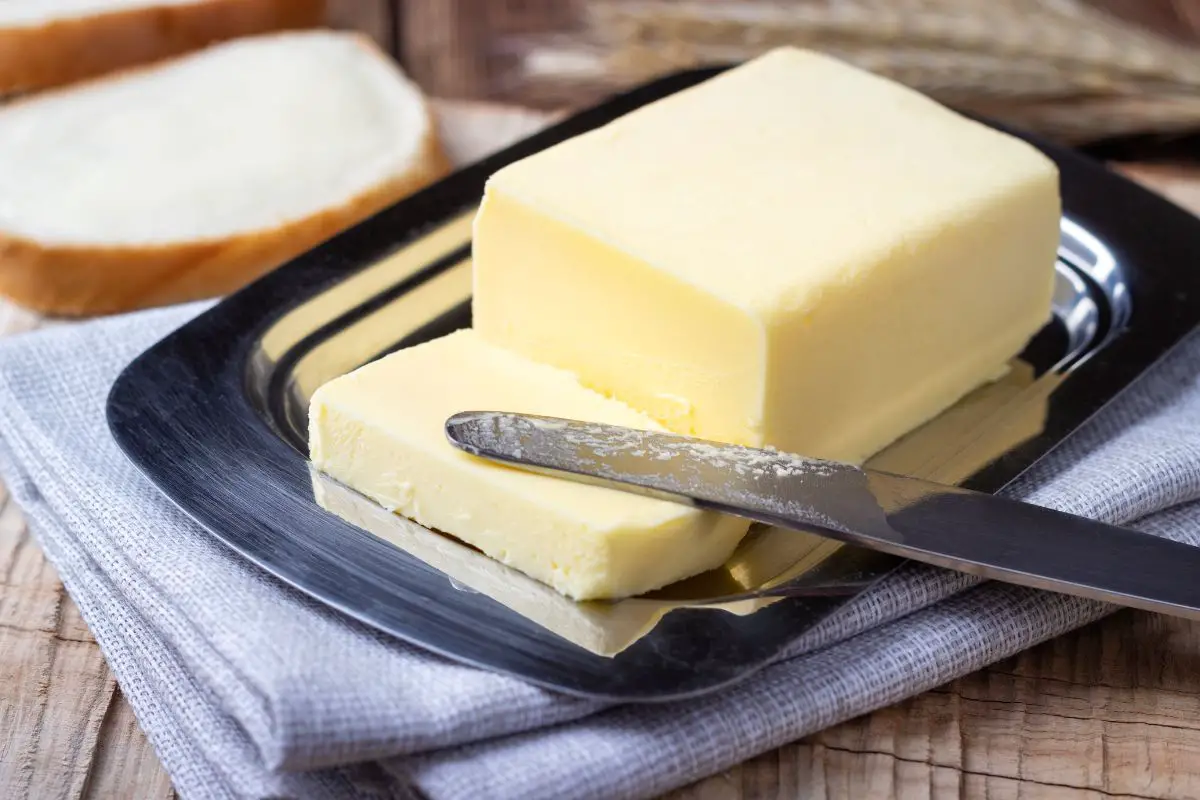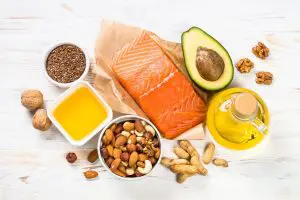Whether you’re already following the keto diet or have been looking into it online, you probably already know that in order to be considered keto-friendly, foods must be high in (ideally healthy) fats and low in carbohydrates and sugars.
This means that butter is a staple food for many of those eating to achieve a state of ketosis. After all, your average butter is roughly 80% fat!
However, it’s important to bear in mind that not all butter is created equal. Because some butter brands include additives in their formulas, there can be hidden sugars and chemicals that you don’t necessarily want when you’re heating for health and weight loss.
We’re going to be reviewing our top 5 keto butters in this article to help you ensure that you’re eating on track to meet your goals. These are some of the best butters we’ve ever tasted, and they’re 100% keto-friendly, so let’s take a look!
The 5 Best Butter Brands For Keto
Isigny Ste Mere Unsalted French Butter

Our top recommendation for keto-friendly butter is this Unsalted French butter from Isigny Ste Mere.
This is a grass fed butter, meaning that it’s richer in nutrients than butter that comes from grain-fed cows.
Just some of the benefits of choosing grass-fed butter over other kinds of butter is that it’s higher in Omega-3 fatty acids, which are a type of polyunsaturated, healthy fat. Grass-fed butter also contains more vitamins and minerals than grain-fed butter, such as vitamin K2, which helps to improve heart and brain function.
In addition to being grass-fed, this French butter meets all the requirements for keto-friendliness. Every serving of the Isigny Ste Mere butter contains 12 grams of fat (approaching 10% of the average person’s daily fat consumption on keto), and there are no carbohydrates or sugars in the formula.
It’s worth mentioning that this butter is also gluten-free, so if you have a gluten intolerance or allergy, this should be safe for you to eat. However, we always recommend contacting the manufacturer directly for information regarding potential contamination.
Something else we love about this butter is the wooden packaging, which not only looks much nicer than your average plastic and foil wrapper but is also better for the environment.
However, this high-quality butter complete with wooden packaging comes at a relatively high price, especially since it’s imported from France, so it’s not particularly budget-friendly.
Pros
- Grass fed – Nutritionally rich
- Carb and sugar-free – Keto-friendly
- 12 g fat per serving – Ideal for keto
- Gluten-free – Celiac-friendly
- Wooden packaging – Eco-friendly
Cons
- High Price Point – Not budget-friendly
Also Available At
Smjor Unsalted Icelandic Butter

Our next keto butter recommendation is the Smjor Unsalted Icelandic Butter.
This is another 100% grass-fed product, so you can be sure that it will provide you with plenty of Omega-3 and vitamin K2.
With 11 grams of fat per serving and 0 grams of carbs, including sugars, this butter is perfect for a ketogenic diet. It’s also gluten-free, so you don’t have to worry about it upsetting your digestive system or causing any other symptoms if you’re intolerant or allergic to gluten.
Smjor butter does not contain any of the antibiotics or hormones that are often seen in less high-quality brands, so there’s also no need to worry about the presence of harmful chemicals or hidden ingredients.
The only downside to making this your butter of choice for keto is the fact that it’s often unavailable both in store and online, which means it’s not the most accessible choice.
Pros
- 100% grass fed – Maximum nutritional content
- 11 g fat per serving – High in fat
- 0 carbs or sugar – Good for keto
- Gluten-free – No grain additives
- No antibiotics or hormones – No synthetic ingredients
Cons
- Sometimes unavailable in store – Not the most accessible
Also Available At
Kerrygold Pure Irish Unsalted Butter

Kerrygold’s Pure Irish Unsalted Butter is another incredibly popular butter due to its delicious, rich taste. However, we think this butter should be talked about even more in the keto community because it’s perfect for a high-fat, low-carb diet.
This butter is totally free from any carbs including sugar, but each serving contains 12 grams of fat. Because the cows that produce Kerrygold butter are mostly grass-fed, you also get plenty of Omega-3 and vitamin K2 from a serving.
We also appreciate that Kerrygold Pure Irish Unsalted Butter is gluten-free, so people with gluten allergies or intolerances can still enjoy it on a keto diet.
Unfortunately, the cows used to produce this butter are only grass-fed for 10 months out of the year, so Kerrygold butter is not 100% grass-fed. While it’s still nutritionally rich and better than totally grain-fed butter, it’s not as nutritious as it could be if it were 100% grass-fed.
However, on the plus side, you can find Kerrygold butter through multiple retailers including Walmart and Target, so it’s very accessible, which isn’t always the case with the best keto butters.
Pros
- Free from carbs and sugar – Suitable for keto
- Sold by several retailers – Accessible
- 12 g fat per serving – Keto-friendly
- Mostly grass fed – Contains essential vitamins and minerals
- Gluten-free – Allergy-safe
Cons
- Not 100% grass fed – Less than full nutritional potential
Also Available At
365 By Whole Foods Market Salted Butter

This salted butter from 365 by Whole Foods Market is one of the most popular butters amongst health-conscious consumers for a variety of reasons. It’s also 100% keto-friendly, so if you’re looking for a safe butter to enjoy as part of your keto diet, this could be the one!
The 365 by Whole Foods Market Salted Butter is grass-fed, meaning that it contains more vitamin K2 and Omega-3 fatty acids than butter produced by cows who haven’t been grass-fed.
There’s no need to worry about the sugar or carb content of this butter because there are exactly 0 grams of each per serving, whereas you will get 11 grams of fat in every serving. Perfect for keto!
Because this is a totally organic butter formula, there are no artificial chemicals in it whatsoever. That includes artificial sweeteners and colors.
This is a salted butter, which is actually ideal for keto because your body loses sodium (an essential electrolyte) when it enters a state of ketosis, so you need to eat more salt to make up for it. The salt content of this butter also contributes to its AA taste grading, which indicates a very pleasing flavor.
Pros
- 11 g fat per serving – High fat content
- No carbs or sugars – Keto-friendly
- Grass-fed – More Omega3 and vitamins
- Organic ingredients – No artificial chemicals
- Graded AA- Highly pleasing flavor
Cons
- Added lactic acid – Not as pure as some other brands
Also Available At
Allgau Grass Fed Unsalted German Butter

Finally, we think you should consider incorporating the Allgau Grassfed Unsalted German Butter into your keto diet.
With 12 grams of fat and 0 grams of carbs and sugars per serving, this butter checks all the boxes needed to identify a food as keto-friendly. Plus, it’s gluten-free, so it’s safe for intolerance and allergy sufferers.
Even better, Allgau’s butter is fully grass fed, so you won’t miss out on essential Omega-3 fatty acids or vitamin K2.
Bear in mind that at 108 calories per serving, this is the most calorific butter on our list, which might be off-putting if you’re doing keto to lose weight. However, the difference between this butter’s calorie content and the next highest is only 3 calories.
The bigger obstacle to using this butter as a keto fat source is the fact that the price is higher due to the cost of shipping, so it’s not the most budget-friendly choice.
Pros
- Fully grass fed – Nutritionally beneficial
- Carb and sugar-free – Optimal for keto
- 12 g fat per serving – High in fat
- Gluten-free – Safe for allergies and intolerances
Cons
- 108 calories per serving – Highest calorie option
- Extra cost for shipping – Not the most affordable
Also Available At
Choosing The Best Keto Butter
We’ve reviewed 5 brands of keto-friendly butter, but which one should you buy? We’re going to help you decide by breaking the decision down into 8 different factors. This way, you know you’ll be making a choice that works for your dietary needs, preferences, and lifestyle.
Fat Content
Since you should be better between 55 and 60% of your daily calories from fat on a keto diet, the first thing you should look at when choosing butter for keto is its fat content.
All of the butters we’ve reviewed today provide between 11 grams and 12 grams of fat per serving. Since the average person will need to consume between 122 and 133 grams of fat per day on a keto diet (assuming they consume 2000 calories per day), this is a significant (but not overly large) portion of the average keto dieter’s daily fat allowance.
Remember that although it’s necessary to eat lots of fat to achieve a state of ketosis, butter should not be your primary fat source, so around 12 grams of fat per serving of butter is ideal.
Carb And Sugar Content
Obviously, when you’re doing keto, you want to limit your intake of carbohydrates and sugars.
You might be thinking that butter doesn’t typically have a lot of carbs or sugars anyway, and you’d be right, but it’s important to check the ingredients label because sometimes there can be additives that increase the sugar or carbohydrate content, especially when it comes to flavored butters.
Luckily, all the butter brands we’ve reviewed today are completely free from carbs and sugar, so you won’t need to worry about this if you stick to the products we’ve recommended.
Grass Fed Or Grain Fed?
Grass-fed butter is typically more expensive than grain-fed, which definitely puts a lot of people off choosing it. However, for the keto diet as well as in general, it’s better to opt for grass-fed butter.
Grass-fed butter contains more Omega-3 fatty acids and vitamin K2. Not only is Omega-3 an important energy source, but it also helps to keep many of the body’s vital organs and systems healthy, including the lungs, heart, circulatory system, and immune system. Vitamin K2, meanwhile, is especially beneficial for heart and brain health.
You can get butters (like Kerrygold) that are grass-fed for a certain amount of the year and grain-fed for the rest. This might be a good option if you want to get most of the benefits of grass-fed butter at a slightly more affordable price.
Salted Or Unsalted?
Another key question you should ask yourself is whether you want salted or unsalted butter. Most of the advice given by experts leans one way (salted), but there are some circumstances where unsalted butter will be the better choice, so you need to decide this for yourself according to your cooking needs and taste preferences.
Not only is it generally agreed that salted butter tastes better than unsalted, but when you’re on a keto diet, there’s another reason to choose salted butter over unsalted.
When your body goes into ketosis, you lose a lot of important electrolytes, one of which is sodium. This means that it’s important to eat more salt during keto to counteract this effect.
With that being said, there are plenty of other food sources from which you can get your salt, and certain recipes (for example, baked goods) will usually call for unsalted butter rather than salted.
So, if you have other staple salt sources in your diet already (enough to meet the 2,000 – 4,000 mg average requirement for those doing keto) and you cook a lot of food that requires unsalted butter, you might want to go unsalted instead.
Gluten Free?
Like carbs and sugars, you might be thinking that butter doesn’t typically contain gluten, and again, that’s true. But, just like with the carb content of butter, the gluten content can be affected by sneaky additives, so it’s always best to check the label if you have a gluten allergy or intolerance.
Taste
Of course, you want your butter to taste good, and the good news is that the best butters for keto (higher fat content) typically taste the best, too.
If you prefer salted butter to unsalted, then we recommend choosing salted butter, especially since you can benefit from the added salt content when doing keto.
If you need some guidance when it comes to choosing the best-tasting keto butter, look for USDA butter grades on packaging. Grade A indicates a very good flavor, whereas AA is ‘highly pleasing’ and considered to be even better.
Price And Accessibility
Unfortunately, buying grass-fed, organic butter usually comes with a higher price tag. It’s important to determine whether a specific brand of butter is affordable for you, and also whether it’s easily accessible.
Packaging
Butter might be the ideal food for a keto diet, but the packaging that butter comes in often isn’t the best for the environment. The foil and plastic wrappers used to package most butter aren’t recyclable, which means it goes into your household waste and ends up in landfill.
One of the butter brands we reviewed earlier (Isigny Ste Mere) uses wooden packaging instead, which is much more environmentally friendly since it can be recycled and repurposed.
Frequently Asked Questions
How Much Butter Should You Eat For Keto?
While butter is a good source of fat on a keto diet, you shouldn’t make it your main fat source because it’s relatively low in other nutrients, even if you opt for grass-fed.
Because most of the fat in butter is saturated, you need to pay attention to how much you’re eating so that you’re not consuming disproportionate amounts of saturated fat compared to healthy fats.
A couple of tablespoons (2 servings) of butter per day should be fine as long as you don’t have too much saturated fat from other sources.
Is Butter Or Margarine Better For Keto?
If you’re trying to lose weight on the keto diet, it’s better to use real butter than margarine. This is because margarine is lower in fat and is essentially a highly refined oil, which is not the kind of fat you want to prioritize when doing keto.
Is Peanut Butter Keto-Friendly?
While we’re on the subject of butter, you might be wondering whether peanut butter is keto-friendly.
Peanut butter does contain plenty of fat and it’s also a good source of protein, so you can have it as part of your keto diet. However, it is significantly higher in carbohydrates than dairy butter. While the amount of carbs in peanut butter doesn’t mean it can’t be keto-friendly, you should opt for unsweetened versions.
Final Thoughts
The best kind of butter for keto will be high in fat, contain no carbs or sugars, and ideally be grass-fed for the increased nutritional content.
Although you can eat butter as part of a keto diet, be sure to moderate your butter consumption and keep an eye on your saturated fat intake on a daily basis.




